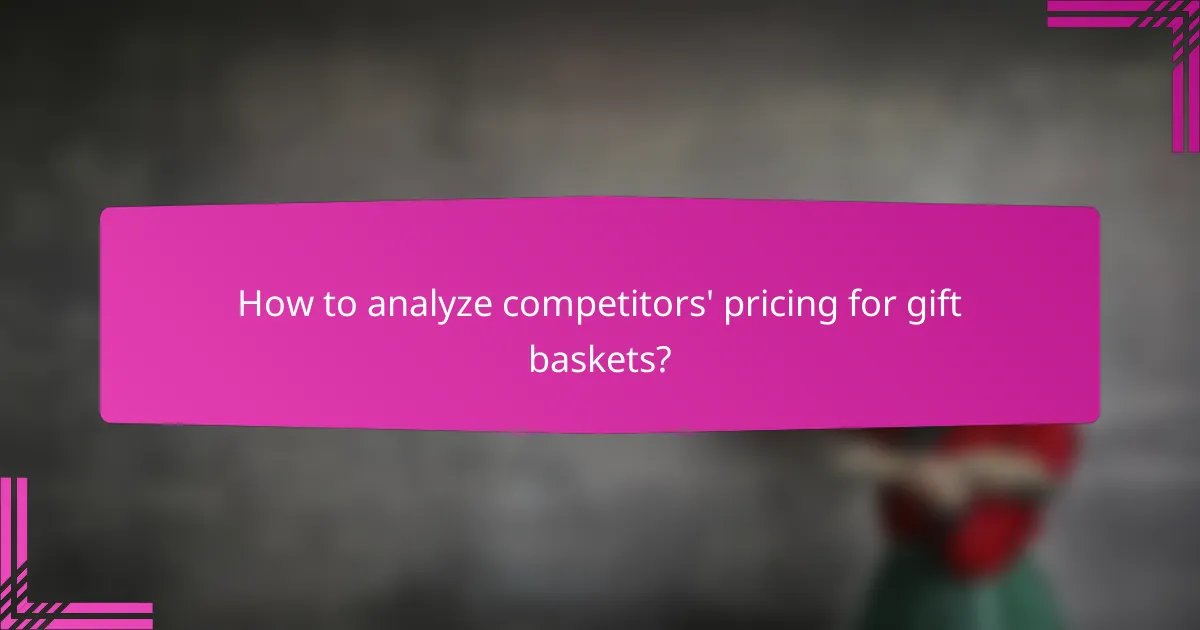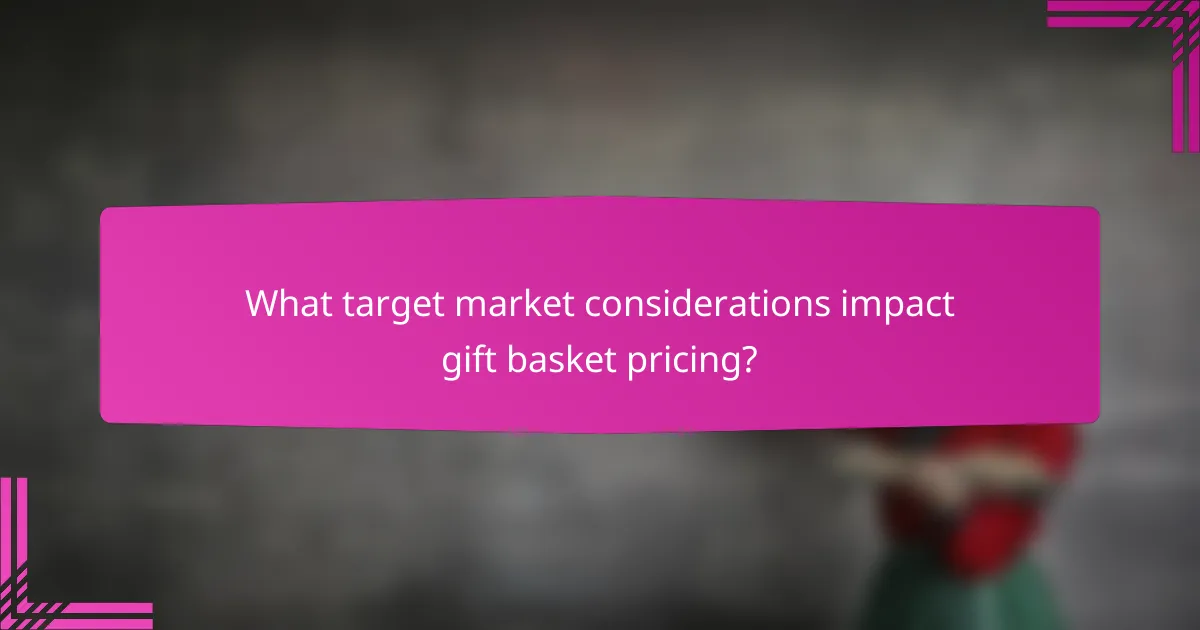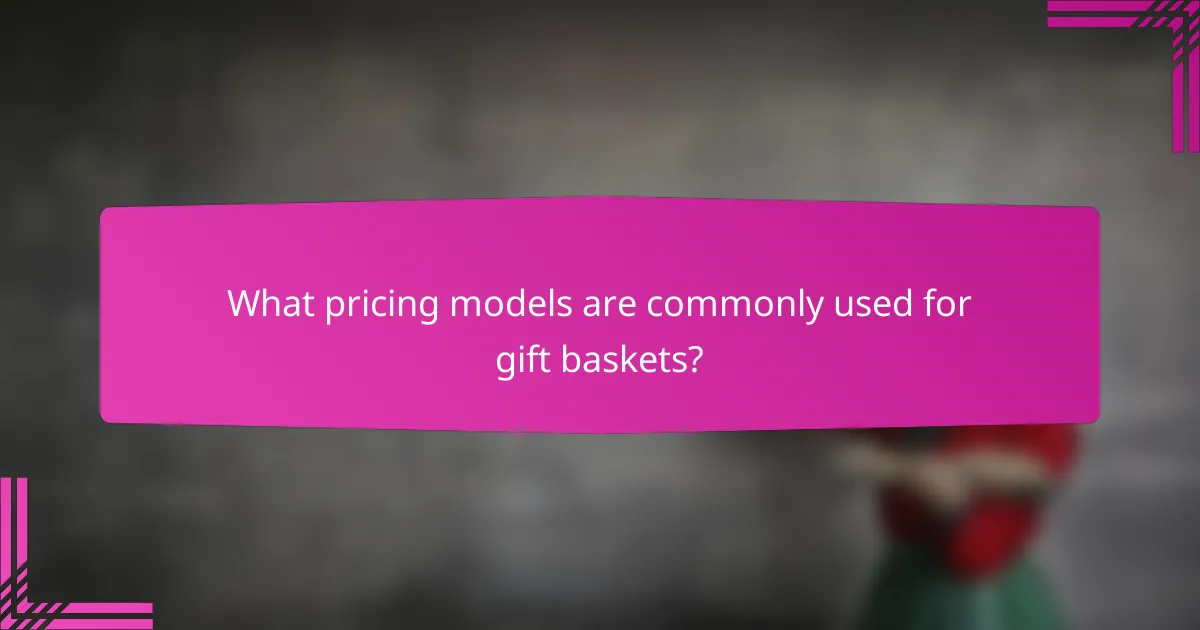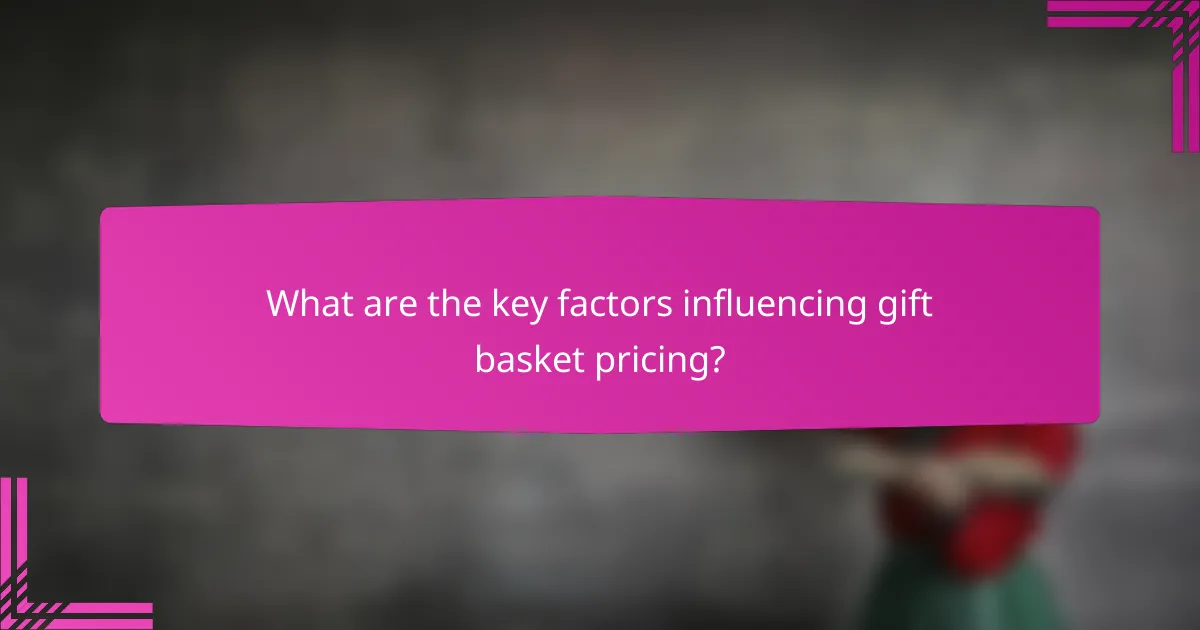Effective pricing strategies for gift baskets require a careful blend of cost analysis, market insights, and psychological pricing tactics. By evaluating production costs, perceived value, and competitor pricing, businesses can set attractive prices that also ensure profitability. Additionally, understanding the target market’s demographics and purchasing behaviors is crucial for positioning products competitively and appealing to specific consumer segments.

What are effective gift basket pricing strategies in the UK?
Effective gift basket pricing strategies in the UK involve a mix of cost analysis, market understanding, and psychological tactics. By considering factors such as production costs, perceived value, and competitor pricing, businesses can set prices that attract customers while ensuring profitability.
Cost-plus pricing model
The cost-plus pricing model involves calculating the total cost of producing a gift basket and adding a markup for profit. This method is straightforward and ensures that all expenses are covered, making it a popular choice for many retailers.
To implement this strategy, determine the costs of ingredients, packaging, and labor, then add a markup percentage, typically ranging from 20% to 50%. This approach provides a clear pricing structure but may not always align with market demand.
Value-based pricing model
Value-based pricing focuses on the perceived value of the gift basket to the customer rather than just the cost of production. This strategy requires understanding what customers are willing to pay based on the quality, uniqueness, and emotional appeal of the basket.
To effectively use this model, conduct market research to gauge customer preferences and willingness to pay. For instance, a luxury gift basket featuring premium products may command a higher price due to its perceived value, even if production costs are similar to standard offerings.
Competitive pricing analysis
Competitive pricing analysis involves examining the prices of similar gift baskets offered by competitors. This strategy helps businesses position their products effectively within the market and can inform pricing decisions to remain competitive.
To conduct a competitive analysis, identify key competitors, compare their pricing structures, and assess the features of their gift baskets. Adjust your pricing to be in line with or slightly below competitors to attract price-sensitive customers while maintaining profitability.
Psychological pricing techniques
Psychological pricing techniques leverage consumer behavior to influence purchasing decisions. Common tactics include pricing items just below a round number, such as £29.99 instead of £30, which can make products appear more affordable.
Additionally, using tiered pricing can encourage customers to spend more. For example, offering three sizes of gift baskets at £20, £30, and £50 can lead customers to choose the middle option, which often maximizes revenue.
Dynamic pricing strategies
Dynamic pricing strategies involve adjusting prices in real-time based on demand, competition, and other market factors. This approach allows businesses to optimize sales and revenue by responding quickly to market changes.
Implementing dynamic pricing requires robust data analytics to track sales patterns and customer behavior. For instance, during peak seasons like holidays, prices may be increased to reflect higher demand, while discounts can be offered during off-peak times to stimulate sales.

How to analyze competitors’ pricing for gift baskets?
To effectively analyze competitors’ pricing for gift baskets, focus on identifying key players, understanding their pricing strategies, and evaluating their product offerings. This approach helps in positioning your own products competitively within the market.
Identify key competitors in the UK market
Start by researching the main companies that sell gift baskets in the UK. Look for both large retailers and niche providers to get a comprehensive view of the market landscape. Popular competitors may include established brands as well as local artisans.
Utilize online platforms, social media, and customer reviews to gather insights about these competitors. This will help you understand their market presence and customer engagement strategies.
Evaluate competitor pricing structures
Examine how competitors price their gift baskets, noting any tiered pricing models or discounts they offer. Prices can vary widely, typically ranging from £20 to over £100 depending on the basket’s contents and target audience.
Consider factors such as seasonal pricing, promotional offers, and bulk purchase discounts. Understanding these structures can inform your own pricing strategy and help you remain competitive.
Assess competitor product offerings
Analyze the variety of gift baskets competitors provide, including themes, sizes, and contents. Look for unique selling points, such as organic products or local sourcing, that might attract customers.
Take note of any customization options available, as personalized baskets can command higher prices. This assessment will help you identify gaps in the market that your offerings could fill.
Utilize pricing comparison tools
Leverage online pricing comparison tools to track competitor prices and promotions effectively. Websites that aggregate product prices can provide valuable insights into market trends and consumer preferences.
Regularly updating your data from these tools allows you to adjust your pricing strategy in real-time, ensuring that you remain competitive without sacrificing profit margins.

What target market considerations impact gift basket pricing?
Target market considerations significantly influence gift basket pricing by determining who the consumers are and how much they are willing to spend. Understanding demographics, purchasing behavior, and seasonal trends helps in setting competitive prices that appeal to specific customer segments.
Demographics of gift basket consumers
The demographics of gift basket consumers include age, income level, and lifestyle preferences. For instance, younger consumers may prefer trendy, themed baskets, while older shoppers might lean towards classic selections. Pricing strategies should reflect these differences, with premium options for higher-income brackets and more affordable choices for budget-conscious buyers.
Additionally, geographic location plays a role; urban consumers may expect higher prices due to increased costs of living, while rural shoppers might seek more value-oriented offerings. Tailoring baskets to local tastes can enhance appeal and justify pricing.
Consumer purchasing behavior
Understanding consumer purchasing behavior is crucial for effective pricing. Many customers buy gift baskets for special occasions like holidays, birthdays, or corporate events, which can drive demand. Analyzing past sales data can reveal peak buying times and help in setting prices that maximize profit during these periods.
Moreover, consumers often compare prices across different retailers, making it essential to maintain competitive pricing. Offering promotions or bundling products can encourage purchases while still aligning with overall pricing strategies.
Seasonal demand fluctuations
Seasonal demand fluctuations significantly impact gift basket pricing. During holidays such as Christmas or Valentine’s Day, demand typically surges, allowing for higher price points. Conversely, off-peak seasons may require discounts to stimulate sales.
Retailers should prepare for these fluctuations by adjusting their inventory and pricing strategies in advance. For example, offering early bird discounts or limited-time offers can attract customers during slower months while capitalizing on peak seasons with premium pricing.
Market segmentation strategies
Market segmentation strategies involve dividing the consumer base into distinct groups based on shared characteristics. This allows for tailored pricing strategies that cater to each segment’s preferences and willingness to pay. For instance, luxury gift baskets can target affluent consumers, while value packs can appeal to budget shoppers.
Implementing tiered pricing models can effectively address different segments. Offering a range of products at various price points ensures that there is something for everyone, maximizing overall market reach and profitability.

What pricing models are commonly used for gift baskets?
Common pricing models for gift baskets include tiered pricing, bundled pricing, and subscription pricing. Each model offers unique advantages and can cater to different target markets, helping businesses optimize sales and customer satisfaction.
Tiered pricing model
The tiered pricing model involves setting different price levels based on the value or quantity of items in a gift basket. For example, a basic basket might start at around $30, while premium options could reach $100 or more, depending on the contents.
This model encourages customers to spend more by showcasing the added value of higher-priced tiers. Businesses should consider offering clear descriptions of what each tier includes to help customers make informed choices.
Bundled pricing strategy
Bundled pricing combines multiple products into a single package at a lower price than if purchased separately. For instance, a gift basket containing gourmet snacks, wine, and a candle might be priced at $75, while the individual items could total $90.
This strategy can increase perceived value and encourage customers to buy more. However, it’s essential to ensure that the bundled items complement each other and appeal to the target market’s preferences.
Subscription pricing for gift baskets
Subscription pricing allows customers to receive gift baskets on a regular basis, such as monthly or quarterly, at a set fee. This model can range from $25 to $100 per delivery, depending on the basket’s contents and frequency.
Subscriptions foster customer loyalty and provide a steady revenue stream. Businesses should offer customizable options to cater to individual tastes and ensure that each delivery feels fresh and exciting to maintain subscriber interest.

What are the key factors influencing gift basket pricing?
Gift basket pricing is influenced by several factors including the cost of ingredients, target market, and competitive landscape. Understanding these elements helps businesses set prices that attract customers while ensuring profitability.
Competitive analysis
Conducting a competitive analysis involves examining the pricing strategies of similar businesses in the gift basket market. This includes reviewing their product offerings, price points, and promotional tactics. By identifying competitors’ strengths and weaknesses, you can position your gift baskets effectively.
For example, if competitors are pricing their mid-range baskets between $30 and $50, you may choose to price yours slightly lower or offer more value through unique items to stand out. Regularly updating your analysis is crucial to remain competitive.
Target market considerations
Understanding your target market is vital for effective pricing. Factors such as demographics, purchasing behavior, and preferences dictate how much customers are willing to spend on gift baskets. For instance, corporate clients may have a higher budget compared to individual consumers.
Surveys and customer feedback can provide insights into what your target audience values most, allowing you to tailor your offerings and pricing accordingly. Consider segmenting your market to create different pricing tiers that cater to various customer needs.
Pricing models
There are several pricing models to consider when setting prices for gift baskets. Cost-plus pricing involves calculating the total cost of items and adding a markup, while value-based pricing focuses on the perceived value to the customer. Each model has its advantages and can be used depending on your business strategy.
For example, if your gift baskets feature premium products, a value-based approach may allow for higher pricing. Alternatively, if you aim for volume sales, a cost-plus model might be more effective. Testing different models can help determine which yields the best results in your market.
